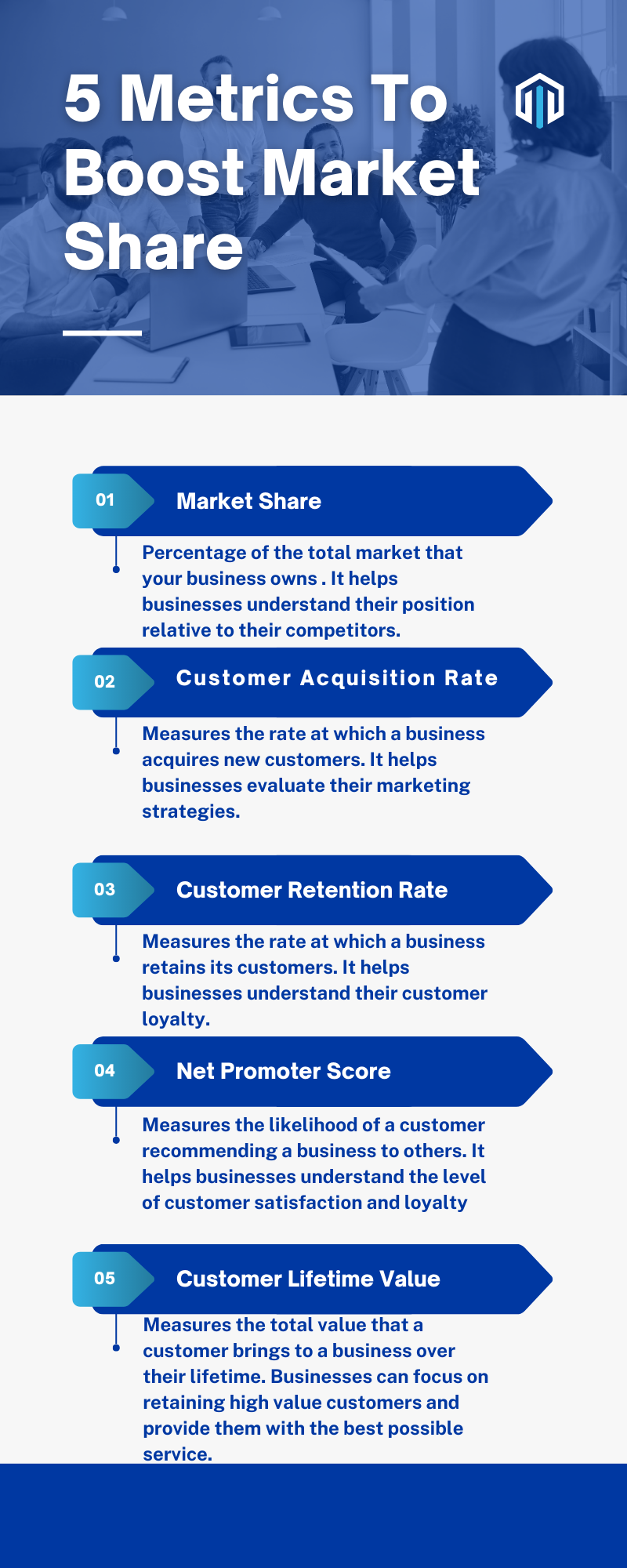
In today’s highly competitive business landscape, it’s essential to keep a close eye on your share of the market. Knowing where you stand relative to your competitors can help you identify areas for improvement and capitalize on untapped opportunities. But how can you measure your share of the market accurately? That’s where metrics come in. By tracking the right metrics, you can gain valuable insights into your market position and stay ahead of the competition.
In this article, we’ll discuss the top five key metrics that you should be monitoring to measure your share of the market. From customer acquisition cost to lifetime value, we’ll cover the metrics that matter most and show you how to use them to make informed decisions about your business. So, whether you’re a startup or an established enterprise, read on to discover the metrics that will help you stay ahead of the game.
The importance of measuring share of market
Measuring the share of the market is essential for businesses to evaluate their market position. It helps them gauge their market share and identify opportunities to increase it. By tracking the market share, businesses can identify their strengths and weaknesses, which allows them to focus on their strengths and improve their weaknesses. Share of market is essential because it helps businesses understand their market position relative to their competitors. Without this knowledge, businesses cannot make informed decisions about where they should focus their efforts.
Understanding the 5 key metrics

To measure the share of the market accurately, businesses must track the right metrics. Here are the top five metrics that businesses should monitor:
Metric 1: Market share
Market share is the percentage of the total market that your business owns. It is calculated by dividing your business’s total sales by the total sales of all businesses in the market. For example, if your business’s total sales are $100,000, and the total sales of all businesses in the market are $1,000,000, your market share is 10%.
Measuring market share is important because it helps businesses understand their position relative to their competitors. If a business has a low market share, it may indicate that they need to increase their marketing efforts or improve their product offering.
Metric 2: Customer acquisition rate
Customer acquisition rate measures the rate at which a business acquires new customers. It is calculated by dividing the number of new customers by the total number of customers. For example, if a business acquires 50 new customers and has a total of 500 customers, the customer acquisition rate is 10%.
Measuring customer acquisition rate is important because it helps businesses evaluate their marketing strategies. If a business has a low customer acquisition rate, it may indicate that their marketing efforts are not effective.
Metric 3: Customer retention rate
Customer retention rate measures the rate at which a business retains its customers. It is calculated by subtracting the number of lost customers from the total number of customers and dividing the result by the total number of customers. For example, if a business has 500 customers at the beginning of the month, loses 50 customers during the month, and has 450 customers at the end of the month, the customer retention rate is 90%.
Measuring customer retention rate is important because it helps businesses understand their customer loyalty. If a business has a high customer retention rate, it may indicate that their products and services are meeting the needs of their customers.
Metric 4: Net promoter score (NPS)
Net promoter score (NPS) measures the likelihood of a customer recommending a business to others. It is calculated by subtracting the percentage of detractors (customers who would not recommend the business) from the percentage of promoters (customers who would recommend the business). For example, if 50% of customers are promoters, and 20% are detractors, the NPS is 30%.
Measuring NPS is important because it helps businesses understand the level of customer satisfaction and loyalty. A high NPS indicates that customers are satisfied with the business and are likely to recommend it to others.
Metric 5: Customer lifetime value (CLV)
Customer lifetime value (CLV) measures the total value that a customer brings to a business over their lifetime. It is calculated by multiplying the average value of a sale by the number of transactions per year and the average length of the customer relationship. For example, if the average value of a sale is $100, the number of transactions per year is 4, and the average length of the customer relationship is 5 years, the CLV is $2,000.
Measuring CLV is important because it helps businesses understand the value of their customers. By identifying customers with a high CLV, businesses can focus on retaining those customers and providing them with the best possible service.
How to calculate and analyze the metrics
To calculate the metrics, businesses need to gather data from various sources such as customer databases, sales reports, and customer surveys. Once the data is collected, businesses can use various tools such as Excel or Google Sheets to calculate the metrics.
To analyze the metrics, businesses should compare their results to industry benchmarks and track changes over time. By doing so, businesses can identify trends and opportunities for improvement.
Using the metrics to stay ahead of the competition.
By monitoring the five key metrics, businesses can gain valuable insights into their market position and stay ahead of the competition. For example, if a business has a low market share, they can focus on increasing their marketing efforts or improving their product offering. If a business has a low customer retention rate, they can focus on improving their customer service or product quality.
The metrics can also help businesses identify their strengths and weaknesses. For example, if a business has a high NPS, they can identify the factors that contribute to customer satisfaction and replicate them across their product offering.
Conclusion
Measuring the share of the market is essential for businesses to stay ahead of the competition. By tracking the right metrics, businesses can gain valuable insights into their market position and identify opportunities for improvement. The key metrics that businesses should monitor include market share, customer acquisition rate, customer retention rate, net promoter score (NPS), and customer lifetime value (CLV). By calculating and analyzing these metrics, businesses can make informed decisions about where to focus their efforts and stay ahead of the competition.
Please also refer to our investment section.

Pingback: Navigating Digital Marketing Ultimate Guide | RichStorehouse